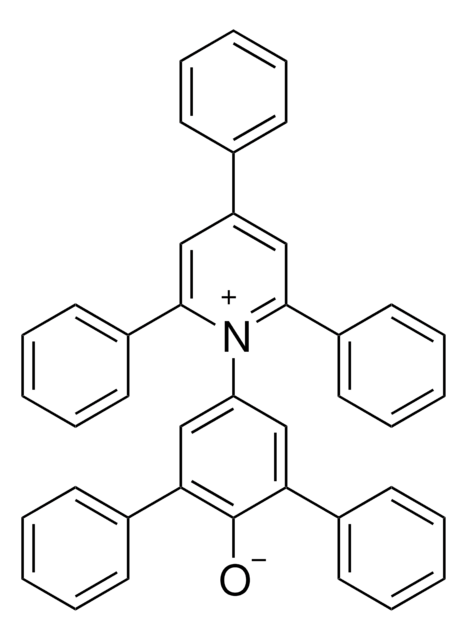Dye solar cells degrade from ultraviolet radiation. For this reason, the barrier may include UV stabilizers and/or UV absorbing luminescent chromophores (which emit at longer wavelengths) and antioxidants to protect and improve the effieciency of the cell.
Wichtige Dokumente
703168
cis-Bis(isothiocyanato)(2,2′-bipyridyl-4,4′-dicarboxylato)(4,4′-di-nonyl-2′-bipyridyl)ruthenium(II)
95% (NMR)
Synonym(e):
Z-907-Farbstoff
About This Item
Empfohlene Produkte
Qualitätsniveau
Assay
95% (NMR)
Form
powder
Zusammensetzung
Dye content, ≥90%
mp (Schmelzpunkt)
196 °C
λmax
531, 314, 295 nm (lit.)
SMILES String
S=C=N[Ru]N=C=S.OC(=O)c1ccnc(c1)-c2cc(ccn2)C(O)=O.CCCCCCCCCc3ccnc(c3)-c4cc(CCCCCCCCC)ccn4
InChI
1S/C28H44N2.C12H8N2O4.2CNS.Ru/c1-3-5-7-9-11-13-15-17-25-19-21-29-27(23-25)28-24-26(20-22-30-28)18-16-14-12-10-8-6-4-2;15-11(16)7-1-3-13-9(5-7)10-6-8(12(17)18)2-4-14-10;2*2-1-3;/h19-24H,3-18H2,1-2H3;1-6H,(H,15,16)(H,17,18);;;/q;;2*-1;+2
InChIKey
LALSZYPVVQFXIC-UHFFFAOYSA-N
Verwandte Kategorien
Anwendung
Rechtliche Hinweise
Signalwort
Warning
H-Sätze
Gefahreneinstufungen
Eye Irrit. 2 - Skin Irrit. 2 - Skin Sens. 1 - STOT SE 3
Zielorgane
Respiratory system
Lagerklassenschlüssel
11 - Combustible Solids
WGK
WGK 3
Flammpunkt (°F)
Not applicable
Flammpunkt (°C)
Not applicable
Persönliche Schutzausrüstung
dust mask type N95 (US), Eyeshields, Faceshields, Gloves
Hier finden Sie alle aktuellen Versionen:
Besitzen Sie dieses Produkt bereits?
In der Dokumentenbibliothek finden Sie die Dokumentation zu den Produkten, die Sie kürzlich erworben haben.
Kunden haben sich ebenfalls angesehen
Artikel
Dye-sensitized solar cells directly convert sunlight to electricity
Operation principle and market dominance of single crystalline silicon solar cells.
Organic materials in optoelectronic devices like LEDs and solar cells are of significant academic and commercial interest.
Dye-sensitized solar cells (DSCs) are 3rd generation solar cells combining the promise of high efficiency with low production costs.
-
What can cause degradation of the dye solar cell?
1 Antwort-
Hilfreich?
-
-
What is the Department of Transportation shipping information for this product?
1 Antwort-
Transportation information can be found in Section 14 of the product's (M)SDS.To access the shipping information for this material, use the link on the product detail page for the product.
Hilfreich?
-
-
What are the advantages of dye solar cells?
1 Antwort-
Dye solar cells (DSCs) are 3rd generation solar cells with the promise of high efficiency combined with low production costs.
Hilfreich?
-
-
What are the disadvantages of dye solar cells?
1 Antwort-
The major disadvantage to the dye solar cell design is the use of a liquid electrolyte, which has temperature stability issues. The electrolyte can freeze at low temperatures and expand at higher temperatures. It the electrolytes freezes, power production would cease, and it could potentially lead to physical damage. If the liquid expands at higher temperatures, sealing the panels would be difficult.
Hilfreich?
-
Aktive Filter
Unser Team von Wissenschaftlern verfügt über Erfahrung in allen Forschungsbereichen einschließlich Life Science, Materialwissenschaften, chemischer Synthese, Chromatographie, Analytik und vielen mehr..
Setzen Sie sich mit dem technischen Dienst in Verbindung.





2 ≥95%](/deepweb/assets/sigmaaldrich/product/structures/190/371/c5efe61d-383f-4364-90c6-1912d88674f3/640/c5efe61d-383f-4364-90c6-1912d88674f3.png)









